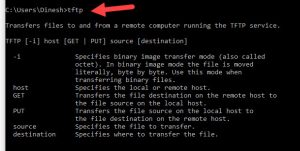

- #TFTP CLIENT WINDOWS COMMAND DD WRT INSTALL#
- #TFTP CLIENT WINDOWS COMMAND DD WRT SERIAL#
- #TFTP CLIENT WINDOWS COMMAND DD WRT UPGRADE#
- #TFTP CLIENT WINDOWS COMMAND DD WRT PASSWORD#
- #TFTP CLIENT WINDOWS COMMAND DD WRT DOWNLOAD#
#TFTP CLIENT WINDOWS COMMAND DD WRT INSTALL#
The router will install the firmware and reboot automatically. Wait a few minutes and you should see "Transfer Successful"Īt this point all you need to do is wait. Open up a CMD window and type in "tftp -i 192.168.1.1 PUT NameOfFirmware.CHK" as shown below. When its done, exit out of the Control Panel. Give Windows a moment or three to install the tftp client. Scroll down the list and place a check in the box next to TFTP Client. From the Programs and Features section, select Turn Windows features on or off.ģ. Open the Control Panel and select the Programs entry.Ģ. If you are using Vista, you need to install it.ġ. You will then use TFTP to put the new firmware on the router. Wait about 5 minutes for the router to reboot and then open up a new CMD window. Type in "reboot" and you should see "Connection to host lost" Once complete, it will again show you a command prompt. Type in "erase linux" and it will run and show you its progress. Once in, you will be shown a prompt that you can use to erase the old firmware. If you have not changed it form the original setup, then they would be Name:admin and Password:password.
#TFTP CLIENT WINDOWS COMMAND DD WRT PASSWORD#
You will then need to type in the name and password for your router.
:max_bytes(150000):strip_icc()/2019-03-16_09h05_05-5c8cf4b9c9e77c0001eb1c05.png)
To do this simply open up a CMD window and type Telnet 192.168.1.1 (or the location of your router) You first have to Telnet into your router. here's a way to accomplish it in Windows without one.įortunately, included in the DD-WRT firmware is an erase utility that will wipe the firmware and allow you to upload a new one.
#TFTP CLIENT WINDOWS COMMAND DD WRT SERIAL#
One way to do it is to use a serial console, but if you don't have one. So, if you decide, for example, to revert back to the original NETGEAR firmware - you can't because that firmware has a filename that ends in CHK.Īs such, this makes it harder to change back.
#TFTP CLIENT WINDOWS COMMAND DD WRT UPGRADE#
the router runs a TFTP client and you need to host the firmware image on a TFTP server.When you upgrade to DD-WRT on your WNR3500L, you'll find that the new firmware requires a file that ends with the BIN extension, if you ever want to upgrade or change your firmware from that point. The below article mainly advises on the first mode of recovery, i.e. many Netgear routers, run a TFTP server in recovery mode, and you need to upload the firmware to the device using a TFTP client.

#TFTP CLIENT WINDOWS COMMAND DD WRT DOWNLOAD#
Other devices do not have automatic pull function and they need you to manually TFTP copy commands in recovery mode to download the firmware via TFTP and initiative the install. Some devices then will automatically pull the network-provided firmware file over TFTP network protocol to the OpenWrt and hopefully recover with a successful emergency flash process. Then device with the broken firmware then has to be started up in TFTP recovery mode. There are two potential modes of operation:įor many routers, the recovery process requires you to host the firmware image on a TFTP server on your computer. In case of a failed flash process or in case of a misconfiguration, the device's boot loader usually remains untouched and can therefore be used to reflash the firmware and recover the device. On most devices, the vendor provides a boot loader on a discreet partition that is untouched by firmware updates. If you keep TFTP-Server running or if you keep the TFTP-client tool available to run anytime, then abusive hackers can abuse/exploit it, to load harmful firmware and/or to change sensitive security settings inside your existing router firmware 1, 2, 3, 4, 5, 6, etc. (frwl rule # 3) TFTP traffic is Not-Allowed when originated from Internet-ip-address (aka: NON private- LAN ip-address ranges)Īnd you must also make sure to do this: after your develop / troubleshooting etc work is done or when you pause to goto other work, then make sure the TFTP-server and TFTP-client both are completely disabled in your OS/distro : turn off TFTP-Server service / process, disable TFTP-server startup script file, and move the TFTP-client ( tftp) & the TFTP-server ( tftpd) executable / binary ( bin) files out of all folders mentioned in your PATH variable, into a different folder (which is NOT in the PATH variable), and also move bin files out of the folder which is mentioned in startup-script (if such is used).


 0 kommentar(er)
0 kommentar(er)
